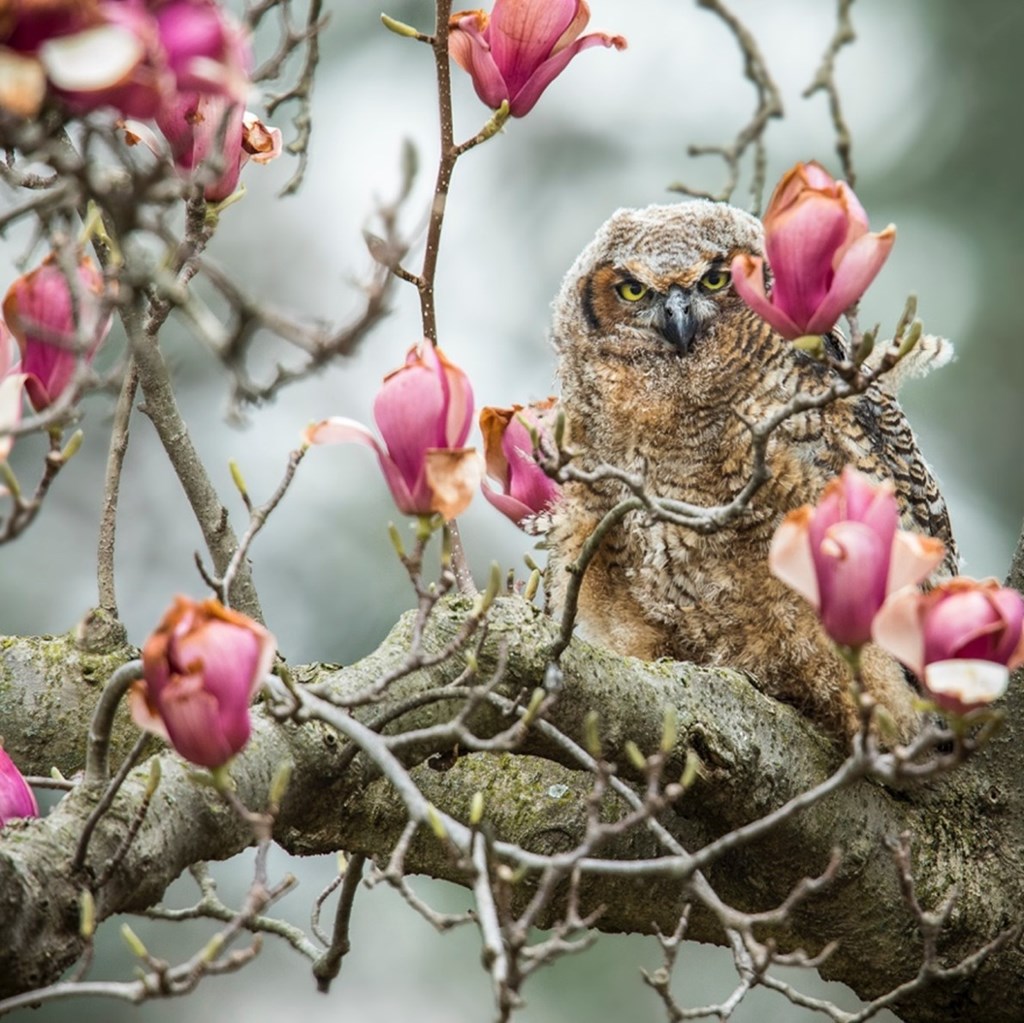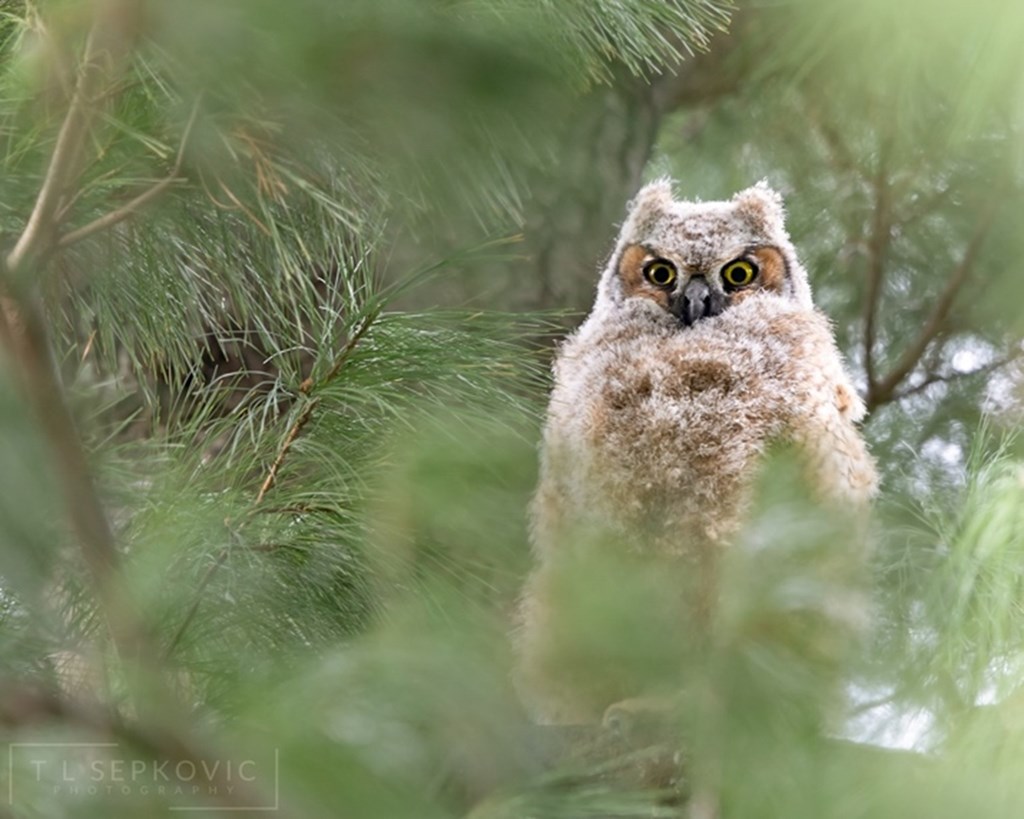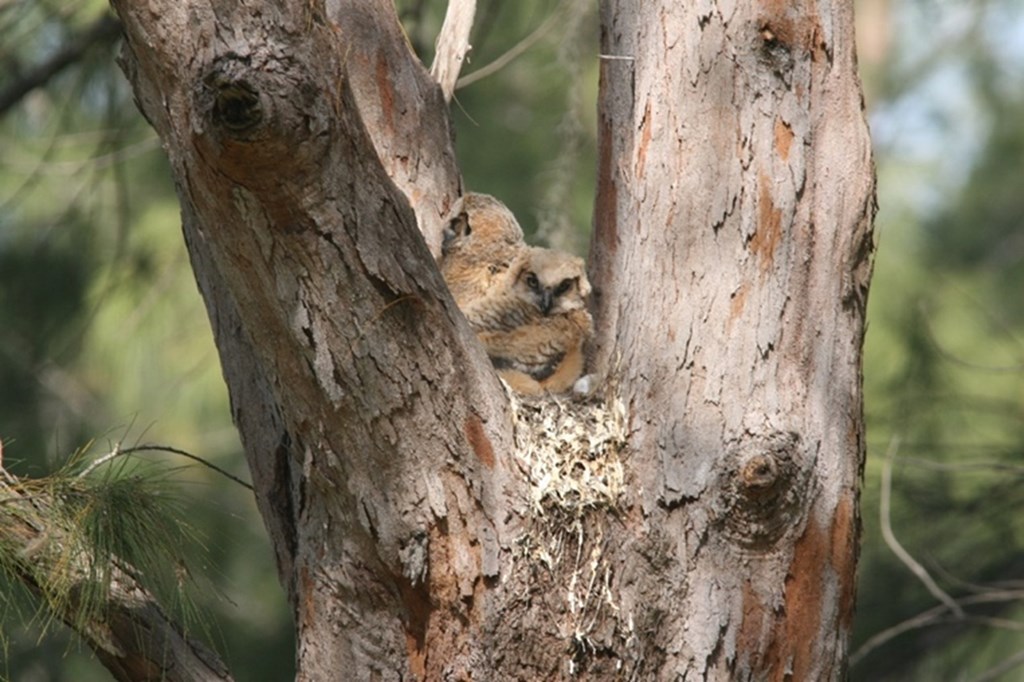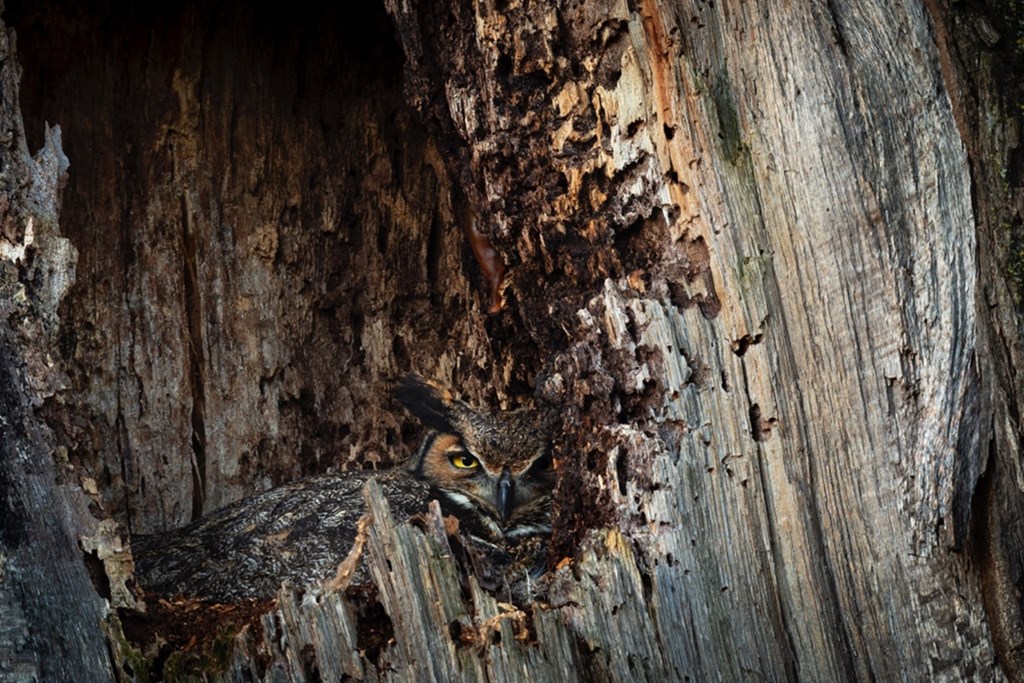Great-horned Owl
Bubo virginianus

Name
The genus name Bubo comes from Latin for “a horned owl” or “owl of ill omen.” The species name virginianus refers to the state of Virginia, where this species was first described. The common name of the great-horned owl refers to its prominent ear tufts.
General Description
Great-horned owls are difficult to misidentify given their large size, noticeable ear tufts and distinct plumage. Both sexes look alike in coloration and pattern. Plumage is a combination of sooty brown, cinnamon, and dusky gray, with barring on the breast. A white throat patch is often visible from the front. Their tail is brown with 5 to 6 dark bars, their facial disk is cinnamon colored with black around the edges, talons and bill are black, and eyes are yellow. Juveniles have white and gray downy feathers on their back and wings, giving an overall fluffed impression. They have less prominent barring than adults, and more gray and rusty pigment. Ear tufts are smaller and less noticeable.
Similar Species: Long-eared owls can be mistaken for great-horned owls given their prominent ear tufts. However, long-eared owls are two-thirds the size of great-horned owls and appear narrower overall. Screech owls are often mistaken for young great-horned owls; in actuality there is little aesthetic overlap aside from their shared ear tufts.
Fun Facts
• Great-horned owl tufts are often mistaken as true ears, when in fact they are tools of camouflage (officially called “plumicorns”) that help the owl’s silhouette better resemble that of a branch.
• Lifespan in the wild is around 20-30 years for a long-lived individual; the oldest recorded great-horned owl was a 50-year-old captive female.
• Great horned owls can exert pressure of over 2000 kilopascals (300 pounds per square inch) when clenching their talons, a vice grip used to sever the spines of prey.
Like most owls, great-horned owls have a limited sense of smell and are known for their willingness to attack and eat skunks.
• One ambitious great-horned owl was found with more than 60 porcupine quills embedded in its body.
• One notable example of great-horned owl adaptability is the choice of some individuals to shift from well-hidden, high roost sites to exposed, low roosts where malaria-carrying black flies are less dense.
• Great-horned owls are the arch enemy of crows. A great way to find a great-horned owl is to follow a screaming mob of corvids that are dive bombing a tree.
Size
| Females | Males | |
| Wingspan | 1.5 m (4 to 5 ft) ✏️✏️✏️✏️✏️ ✏️✏️✏️ 8 pencils end to end | Same |
| Mass | 1.54 kg (3.4 lbs) 🍈🍈 1-2 melons | 1.22 kg (2.7 lbs) 🍈 A little over 1 melon |

Vocals
Great-horned owls are one of the few owls that actually hoot. Their recognizable “Whose awake? Me toooo” vocalization can be heard across North America. However, like other owls, great-horned owls exhibit a repertoire of different vocalizations indicating various behavioral states such as territorial defense, sexual excitement, begging, and distress. Individual great-horned owls can be told apart based on the number of notes they give, as well as the interval between them.
Habitat
Great-horned owls are one of the most widespread raptors in North America, occupying deserts, rainforests and virtually every habitat in between. Renown author Scott Weidensaul said in his book Owls of North America and the Caribbean, that listing the habitats where great-horned owls are not found would be easier than listing where they are. They especially thrive in fragmented edge habitats, and exhibit adaptability in human-dominated landscapes. They are found less often in open fields or dense interiors of mature forests, although nesting does occur in the latter, potentially because of the greater maneuverability afforded in forests with less undergrowth.
Great-horned owls often roost in conifers or dense deciduous trees that offer concealment during daylight hours, though crows are notoriously adept at harassing great-horned owls regardless of where they are “hidden” or not.
Feeding
The diet of great-horned owls reflects their adaptive lifestyle. Although they prefer mammals, they commonly dine on birds, reptiles, amphibians, insects, fish, crustaceans, carrion, and even scorpions. A hungry great-horned owl will eat what is available. Studies show that mammals compose roughly 90-94% of biomass in the diet of great-horned owls from several North American sites, while birds make up 5-11%. These percentages are, of course, dependent on where the birds are living; for example, a nesting pair in North Dakota fed their nestlings 90% birds, while pellets beneath one Pennsylvania nest were filled with catfish remains. Adding to the uncertainty of dietary assessments is the fact that body parts of some prey, such as small songbirds, do not preserve well in owl pellets and therefore may be underrepresented in pellet studies.
Great-horned owls will eat other raptors, and readily hunt red-tailed hawks, osprey, red-shouldered hawks, nestling bald eagles, other owls, and even on occasion other great-horned owls. These interactions do not always end well for the attacker; great-horned owls have been found bearing evidence of snake retaliation, puncture wounds from hawk talons and embedded porcupine quills.

Nesting
Courtship begins as early as autumn, making great-horned owls one of the earliest breeding raptors in North America. Pair-bonding, hooting and beak rubbing are the primary courtship behaviors. The white throat patch is often exposed during hoots, potentially as a signal during low light conditions. Researchers theorize that pairs may stay together for life, though this has not been empirically proven.
Great-horned owls use secondary nests (most often former red-tailed hawk nests) located in trees, caves, cliffs, and even old buildings. Same-species nests in selected study areas are typically 1.6 kilometers (1 mile) apart, although this pattern of distance might also be the result of red-tailed hawk nest distribution. Females in mid latitudes lay eggs between December and January. Such an early nesting date gives great-horned owls top choice of sites, providing an advantage when space or nest quality is a limiting factor for prospecting birds.
Incubation lasts for an average of 33 days and is done entirely by the female. Clutch size ranges from 1 to 5 eggs with an average of 2. Great-horned owls are capable of double-clutching, meaning that if the first clutch fails the female may lay another. However, usually fewer eggs are laid the second time, and they are smaller.
Nestling great-horned owls eat what their parents eat, although as one would expect, the amount of biomass brought to the nest is linked to the efficiency of the parents, the availability of prey, and the number of young. Each nestling is fed roughly 300 grams (10.5 ounces) of food per day, and size of prey increases with nestling age.
Flight feathers emerge around 5 to 6 weeks of age, around the same time that nestlings begin experimenting with their mobility, jumping around on branches and sometimes ending up on the ground. This stage is called the “branching” stage. Fledging occurs around 9 weeks of age, although like other large species such as snowy owls, the fledglings remain within their parent’s territory until autumn or later. They learn to hunt while still benefiting from the protection of their parents, and therefore young great-horned owls have a relatively high survival rate.
Migration
Great-horned owls are mostly residential (non-migratory). Although northern subspecies may move south during winter, a study conducted in the Yukon concluded that during the summer, pairs rarely moved more than 3 kilometers (1.8 miles) from breeding territories held the year before. Great-horned owl winter irruptions (see snowy owl species account) do sometimes occur in response to snowshoe hare population cycles; however, the trigger seems to be a low abundance of hares, rather than a prey surplus, as is the case for snowy owl irruptions. During low hare years, northern great-horned owls may move south. Juveniles are more likely to disperse than adults, as they are scoping out territories and learning the ropes.

Current Conservation Status
Given their broad range, great-horned owls are listed as a species of Least Concern on the IUCN Redlist. However, the North American Breeding Bird Survey reported a 33% decline across their range between 1966 and 2015. West Nile virus appears to be one of the main causes, although mothers may now be able to pass antibodies on to their chicks.
Historically, great-horned owls were a common target for gunners. Since 1972 great-horned owls have been protected, however shooting still exists on a smaller scale presumably in retaliation to owls killing domestic animals such as rabbits, chickens, ducks, and other easy targets. Great-horned owls also consume choice game such as hares, and at times they may be shot in hopes of reducing competition. We now know, however, that removing predators does not result in more game over the long term.
Generally speaking, great-horned owls have been consistently adaptable to environmental change. The largest danger they face is an occasional negative reputation amongst their human neighbors.
How can you help great-horned owls?
Founder of Hawk Mountain Rosalie Edge once said, “the time to protect a species is while it’s still common.” Great-horned owls are still common and thriving. The best gift we can give them is an attitude of understanding; by reading this species account, you are already helping. By sharing what you’ve learned and cultivating a culture of appreciation around great-horned owls, you’ll be doing even more. They play a significant role in the healthy interactions between trophic levels of the food web. Furthermore, they are effective rodent-removal agents, and in this way can provide benefits to humans. Great-horned owls are a symbol of strength, adaptability, and prowess across North American landscapes, and with support from us, they will remain a cultural treasure.
Special thanks to Chris Brinkman, Jesse Amesbury, and Traci Sepkovic for their generous photo contributions to this account.
Information written and compiled by Zoey Greenberg.
Sources
Cornell Lab of Ornithology. (2019). All About Birds: Great-horned Owl. Retrieved from
https://www.allaboutbirds.org/guide/Great_Horned_Owl/lifehistory
Johnsgard, P. A. (1988). North American owls: biology and natural history. Washington, D.C.: Smithsonian Institution Press.
Weidensaul, Scott. (2015). Owls of North America and the Caribbean. New York: NY.: Peterson Field Guides.